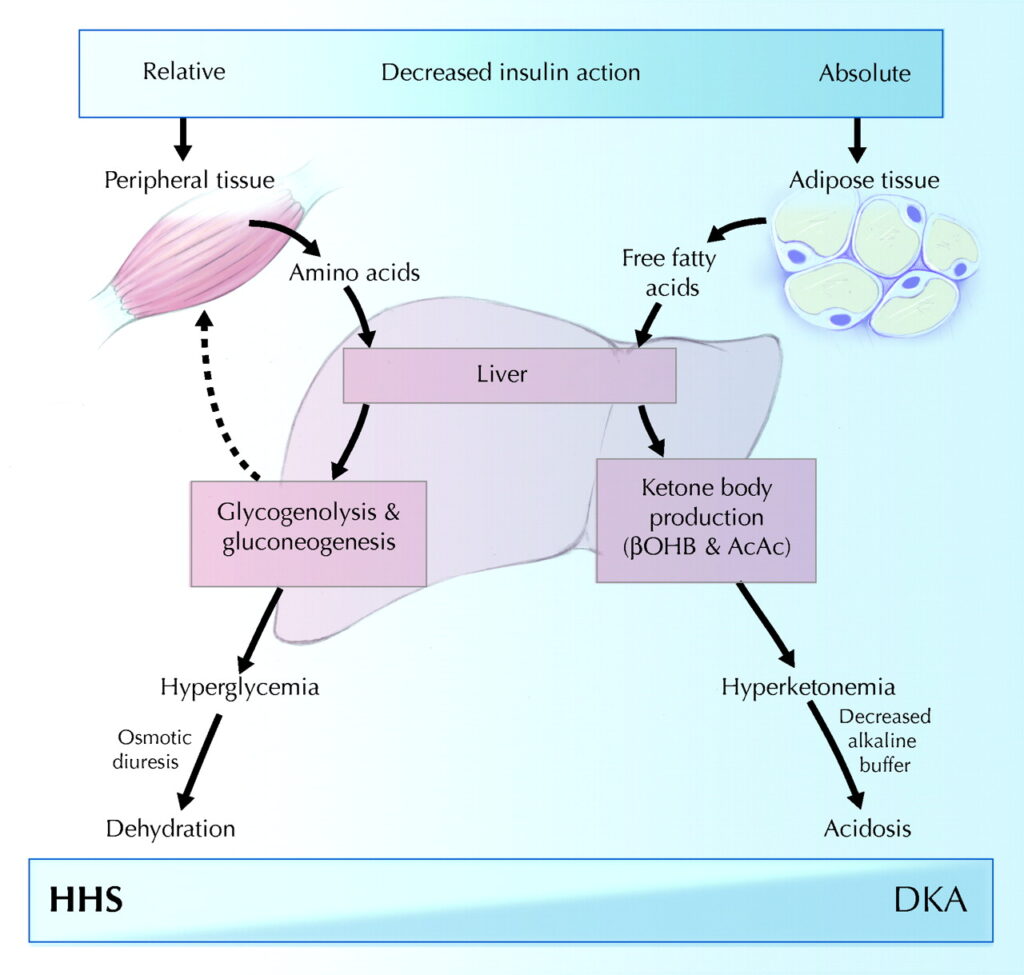
Nonketotic hyperosmolar coma is characterized by extraordinarily high plasma aldohexose while not pathology. aldohexose values might exceed a thousand mg/dl, making a sufficient osmolar load to supply important changes in water distribution. Symptoms sometimes embody kidney disease and thirst with weakness or lethargy. Hyperosmolar Nonketotic Coma
Diagnosis And Treatment of Hyperosmolar Nonketotic Coma
HHNS is diagnosed based on symptoms and by measuring blood glucose levels, which can be done with a finger stick. Hyperosmolar Nonketotic Coma
A blood glucose level of 600 mg/dL and a low ketone level are important prognostic factors for HHNS.
Serum osmolality, a test that measures the body’s water/electrolyte balance, is also used to diagnose HHNS. Serum osmolality specifically measures chemicals dissolved in the liquid portion of blood (serum), such as sodium, chloride, bicarbonate, protein, and glucose.
Diagnosis is made by clinical examination of the patient’s symptoms and history of complications and risk factors. Glucose levels are sometimes greater than 600 mg/dl and humoral osmolality greater than 320 mm2 is required for detection. Hyperosmolar Nonketotic Coma. Hyperosmolar Nonketotic Coma
Treatment includes rapid administration of hormones and fluids to normalize glucose levels and adequate dehydration. Fluids should be draine at least thirty hours before the hormone. Electrolytes such as Na, potassium, magnesium, and phosphate are replace pro-Renata. Some patients may have associated antibiotics if the infection is a gift.
Treatment usually involves starting intravenous (IV) fluids (a saline solution injected into a vein through a needle) to rapidly hydrate the body. He may also need IV insulin to lower blood sugar levels.
Replenishment of potassium and sometimes sodium phosphate may also be necessary to support cell function.
If you are hospitalize for HHNS, you may be kept for observation overnight. The main goal of treating this condition is to identify the underlying factors, whether it is an infection, a certain medication, or poor blood sugar management.
It is important that a person experiencing HHNS gets professional medical care immediately, as complications can include seizures, coma, brain swelling, or even death if left untreated.
Symptoms
Symptoms of hyperosmolar hyperglycemic coma include:
- Hyperglycemia
- Lethargy and general weakness may progress to exhaustion and even collapse.
- Symptoms of severe dehydration due to hyperglycemia such as increased thirst, dry mouth, and sunken eyes
- Confusion and sleepiness
- Hallucinations
- Increased heart rate
- fever
- Convulsions
Prevention of Hyperosmolar Nonketotic Coma
The best way to prevent this serious condition is to manage your diabetes: 7
Check your blood sugar according to your healthcare provider’s instructions. You should check your blood every four hours when you are sick. When your body is fighting a virus or infection, your blood sugar is naturally high.
Taking your diabetes medications, including insulin, as directed by your healthcare provider.
Drink plenty of fluids every day, especially when you’re sick.
Staying in touch with your diabetes healthcare team when your blood sugar is consistently above 300 mg/dl
Staying up-to-date on vaccines, including getting an annual flu shot and discussing pneumococcal vaccine recommendations with your healthcare provider
How Is HHNS Different From Diabetic Ketoacidosis (DKA)?
Unlike HHNS, DKA is almost exclusively a condition that occurs in people with type 1 diabetes.
A lack of insulin causes a build-up of glucose in the blood that cannot be used by the body’s cells for energy. The body compensates by finding an alternative energy source in stored fat. When store fat is use for energy, it produces toxic waste products call ketones, which can poison the body. Hyperosmolar Nonketotic Coma
HHNS does not produce ketones, and the symptoms of DKA vary, including:
- Fruity breath.
- Difficulty breathing
- Nausea and vomiting
- A fast and weak pulse
- Stomach pain
A Word From Verywell
The best way to prevent HHNS is to keep your blood sugar levels under control. Check them regularly using a glucometer, work with your healthcare provider to make sure you’re taking any diabetes medications as prescribed, and monitor for high glucose and water levels. Know the warning signs of deficiency, such as excessive thirst and frequent urination, so you know to treat it when you need it. Educate loved ones and co-workers to recognize the early signs of blood sugar imbalance, so they can also seek help. Hyperosmolar Nonketotic Coma

